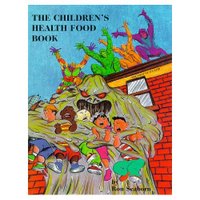
I'm sure you've all seen this little pink cookbook winking at you from store shelves everywhere.
Deceptively Delicious
is so popular that even now, almost eight months after its publication, it is still a "7 Day Only" loan at our library. Well, this week I finally got a chance to check it out myself!
The basic idea here is that if you want to end the struggle over vegetables at mealtime, start sneaking vegetable purees into foods your kids love, like mac and cheese or brownies. Then sit back and smile to yourself as they eat their vegetables in blissful ignorance.
Vegetable subterfuge, you say? Well, bring it on! I've been using the magical blender to erase any hint of certain vegetables in my family's dinners for a long time, and so have a lot of my readers. In fact, last March I wrote
"Let's Hear It For Sneaky Mommas!", a special post raving about my blender and asking for more sneaky ideas from you readers (My favorite was blending spinach into mashed potatoes and calling them "swamp potatoes". Genius.)
Eager for even more ideas, I looked through
Deceptively Delicious
for some vegan recipes I could start with. I found....Ketchup. That's right, the recipe for homemade Ketchup was vegan. Everything else would require at least some substitutions, mostly in the egg and dairy department. Even the recipes for avocado spread and salsa dip contained dairy!
Some of the recipes looked worth veganizing, though: I loved the idea of adding yellow squash puree to a simple dish of "Buttered" Noodles. I would substitute nondairy milk and some nutritional yeast in place of the milk and Parmesan. The recipe for Creamy Potato Soup with secret butternut squash and cauliflower sounded excellent. I would substitute vegetable broth for the chicken broth, nondairy milk and a splash of lemon juice for the buttermilk, and leave out the cheddar cheese.
Oddly enough I had more luck finding vegan options in the dessert section: Blueberry Oatmeal Bars, Chocolate Chip Cupcakes (without the frosting), Chocolate Fondue, and Fruit Punch were all vegan. Yum!
But on closer inspection, I really started to wonder about some of these "deceptive" dishes. For example, the Blueberry Oatmeal Bars contained 1/2 cup spinach puree. The recipe serves 12, so doing my math...that's about 2 teaspoons of spinach per serving.
Really? I mean, I know a spoonful of sugar helps the medicine go down, but all that effort -- cooking, pureeing, freezing, and thawing -- to get two teaspoons of spinach into the kids? Is it really worth it to sneak 2 teaspoons of spinach into an oatmeal bar, or, for another example, 1 teaspoon of cauliflower into the frosting on your child's chocolate cupcake?
Ultimately, I don't think a vegan could easily get their money's worth out of this one, and although I applaud the effort and the many helpful tips and ideas here, perhaps it's best to stick to just a few of the recipes that contain larger amounts of the vegetable purees. Add some cooked vegetables and a salad on the side and some fresh fruit for dessert. If you do this most nights you can probably skip the deception the rest of the time and let cupcakes be cupcakes.
 This week Emily Davidson was kind enough to send me a review copy of her new book, 101 Tips: Healthy Eating, Naturally.
This week Emily Davidson was kind enough to send me a review copy of her new book, 101 Tips: Healthy Eating, Naturally.




